Scholars' insights on Open City: London, 1500–1700
This article, part of Open City: London, 1500–1700, one of the Exhibitions at the Folger, offers modern insights into early modern London.
Survey of London (case 1)
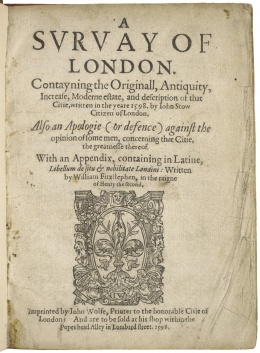
Kathleen Lynch on Stow's Survey of London.
We know a lot about late sixteenth-century London thanks to John Stow's Survey of London. But what we may not know is that Stow was not as interested in producing a description of the London of his time as he was in recovering or preserving the London of an earlier era—the London that was passing out of memory and away from the cityscape. Stow's Survey is a systematic description of the city, figuratively moving through it around the walls, through the gates, and into the wards. But the movement of Stow's narrative is not just oriented around topographical or geographical features of the landscape. Stow is as interested in a temporal movement—in a movement back in time through the layers of history. He was particularly interested in place names that promised an association with some activity or trade, but where there was no longer evidence of that activity. Why no poulterers in Poultry Lane? No chandlers in Candlewright Street? Why no Jews in the Jewry? Stow's Survey was first published in 1598—almost immediately he was revising it and the second edition was published in 1603. The work continued to be edited and revised by others even after his death until, by the end of the seventeenth-century, it had grown into a two-volume folio, richly illustrated, and one of those volumes is on view directly across the hall.
Listen to Lynch discuss Stow's important work.
Kathleen Lynch is Executive Director of the Folger Institute and curator of this exhibition. Her research interests include the intertwined histories of regulations of religion and the book trade. Her book, Protestant Autobiography in the Seventeenth-Century Anglophone World, was recently published with Oxford University Press (spring 2012).
Repurposed religious properties (case 2)

Kathleen Lynch on vanishing monasteries.
Here is an engraving of St. John's Hospital in Clerkenwell. The Knights Hospitallers were one of two crusading orders that established their English headquarters in London in the twelfth century. They were originally founded to aide pilgrims to Jerusalem. By the mid-sixteenth century, they were fighting the Ottoman Turks from their island stronghold of Rhodes and, then later, Malta. London was filled with the large compounds that served as headquarters for religious orders. Their closure by King Henry VIII set off a redistribution of wealth and a large scale building boom. Their closures also shifted the responsibility for social services onto the parishes and the city government. Just as these religious orders had very different histories, they also had different fates after their closures. St. Mary's Bethlehem was run as an insane asylum. The Crutched Friars became a glassworks factory. Charter House was rebuilt as an aristocratic home. St. John's Hospital was turned into a warehouse for the Office of the King's Tents and Revels, for a time. Then, during Edward VI's reign, the Lord Protector Somerset took some marble stones from the priory and added then to the building site of his new home on the Strand.
Hear Lynch tell of how the crown redistributed the church's wealth.
Shakespeare’s Blackfriars deed (pilaster before case 3)

Betsy Walsh on Shakespeare's townhouse at Blackfriars.
By 1613, lodging at Blackfriars was becoming fashionable, so it’s really not surprising that Shakespeare decided to invest in property there. The gate house stood only a few hundred yards from the Blackfriars Theatre, the winter home of Shakespeare’s acting company, the King’s Men. It was also near the Thames, which provided easy water access to the Globe Theatre on the south bank. Fellow actors, including Richard Burbage, already owned property at Blackfriars. There is no evidence that Shakespeare ever intended to make this his home. Note the wavy edge at the top of the document. This is a standard form of contract at this time. Two identical copies of an agreement would be written out on a sheet of vellum or paper. The two copies would then be cut apart with one edge indented or serrated. It’s from this practice that we derive the term “indenture”. In the event there was ever a contractual dispute between the principal parties or their heirs, the two documents would be brought back together. If the edges match, the contract was valid. This is Shakespeare’s own copy of the deed of purchase. As the purchaser, he was not required to sign his portion. You can see the seller, Henry Walker’s signature, at the bottom of the deed. Walker’s half, signed by William Shakespeare and several of his trustees, is currently in London’s Guild Hall Library.
Listen to Walsh discuss Shakespeare's investment.
Elizabeth (Betsy) Walsh is Head of Reader Services at the Folger and consultant to this exhibition. She has served as a curator and consultant for a number of Folger exhibitions including The Reader Revealed (2001), Voices for Tolerance (2004) and Breaking News (2008).
Trade company shields (pilaster before case 4)
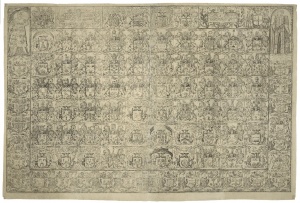
Ian Gadd on trade companies.
One of my favorite items in the Folger collection is an engraving from 1596. Within it are dozens of compartments, each containing a single coat of arms. The main body consists of the arms of London’s sixty trade or craft companies, around which of the arms are the crown, the city, four merchant companies, and England's twenty-six cathedral cities. The engraver, Benjamin Wright, is obscure, but if you look at the top left you'll see that he describes this as the first fruits of his labors. Take a moment to examine the companies. You'll see familiar crafts and trades—grocers, shoemakers, goldsmiths, plumbers, brewers—alongside more obscure ones—girdlers, couriers, loriners. My own interest is the stationer's company which regulated London's book trade. Its coat of arms can be found in the sixth row, ninth from the left. If you look closely, you can see a number—48—which indicates its ranking for city events while its coat of arms shows three books, two Tudor roses, an eagle, and, at the top, the Holy Spirit. At the bottom is the company motto. The arms of the companies must have been familiar to many in London. They were not only on display in their halls and during city parades, but also appeared on everything from buttons to guns, from snuffboxes to funeral palls. What this engraving did was to bring all of them together on a single page. And, in fact, you can still buy similar posters of the companies in London to this day.
Listen to Gadd discuss trade coats of arms.
Ian Gadd is a Senior Lecturer in English at Bath Spa University UK. He co-edited an edition of Swift’s Political Writings 1711–14 with Bertrand A. Goldgar (2008) and is editing Volume 1 (1478–1780) of the History of Oxford University Press (Oxford University Press, 2012).
Cheapside market (case 4)
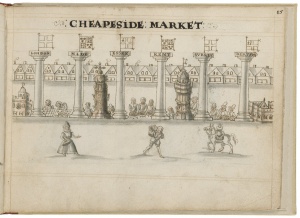
Natasha Korda on Cheapside market.
Hugh Alley's Caveat for the City of London of 1598 presents us with a very orderly depiction of Cheapside Market, in which male and female vendors sell a variety of foodstuffs underneath labeled “pillars” which are labeled for their home counties. It’s important to remember though, when we look at this image, that it’s a highly idealized image of Cheapside that’s showing us the market as Hugh Alley would like it to be, including the reforms that he is proposing to the Lord Mayor of London. In fact, Cheapside Market and the other formal marketplaces in London during the late sixteenth-century were quite disorderly places as a result of the city's exponential population growth. You had swarms of people migrating into the city to sell their wares and, as a result of this, the formal marketplaces were overrun with street hawkers and hagglers. Alley complains about them in the text of his manuscript and, in particular, about market women known as hawkers and hucksters and regrater, who bought up wares and sold them elsewhere. So, the image that Hugh Alley presents us with is one of the marketplace as he would like it to be, an idealized image rather than showing us what Cheapside Market actually was in the late 16th century.
Hear Korda discuss Alley's image of Cheapside versus the reality.
Natasha Korda is Professor of English and Chair (2009-11) of Feminist, Gender and Sexuality Studies at Wesleyan University. She is the author of Shakespeare’s Domestic Economies: Gender and Property in Early Modern England (2002) and Labors Lost: Women’s Work and the Early Modern English Stage (2011), and several co-edited volumes of essays.
Parish pew chart (wall above case 5)
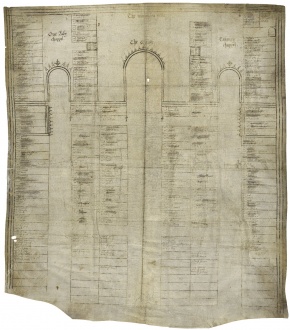
Ken Fincham on assigned seats at church.
Here is a pew plan of the church of St. Margaret’s Westminster. In 1615, the church wardens purchased a large piece of vellum, or animal skin, and paid a scrivener to write in what they called a map of the pews. If we look closely, we can see that some names have been scratched out and new ones written in over them. This is because this is vellum which is quite tough and can cope with such reworking, unlike paper. The pew plan gives us a wonderful insight into the parish community of St. Margaret's Westminster. If you were to wander into any church on a Sunday morning in the spirit, you could tell at a glance who was important and who wasn't. People were ranked or seated according to their status—the wealthy and the influential at the front, the poor, the servants, and the young at the back. But this pew plan also demonstrates that men and women sat separately from one another even within the same families. When new pews were added or old ones altered, some people need to be reseated and this could cause a good deal of argument within the parish for some families claim they deserve to be promoted and others should be demoted. And that's exactly why this sort of document was drawn up. It was the fruit of some serious negotiations by the church wardens and other senior members of the parish. Such pew plans exist elsewhere in seventeenth-century England and each of them represent an attempt to maintain peace within the parish. Everyone knows where they sit.
Listen to Fincham discuss changes made to a map of pews.
Ken Fincham is Professor of History at the University of Kent. Recent writings includes Altars Restored: the Changing Face of English Religious Worship, 1547–c.1700 (2007), co-authored with Nicholas Tyacke.
Imagining a new St. Paul’s (pilaster after case 5)
Kathleen Lynch on Henry Farley.
One unsung hero of what might now be called the Friends of St. Paul’s was Henry Farley. Farley was a scrivener or a legal clerk. He thought that the decrepit state of the Cathedral after its spire was struck by lightning in 1561 was a public disgrace and he spent the better part of a decade trying to secure commitments to save the Cathedral. In 1616, Farley commissioned the painter John Gipkyn to visualize his dream of a splendidly revitalized cathedral in this diptych or two-paneled painting. When the diptych is closed, one sees a royal procession moving across the London Bridge and into the city. The piece opens to reveal a scene of perfect social order. All of those dignitaries—clergymen and civic leaders and above all the king, James, in his royal balcony box—are assembled at the outdoor Paul’s Cross pulpit for a sermon. The final panel shows a gleamingly-restored cathedral. Indeed, King James did come to St. Paul’s in 1620 to hear Bishop King preach a sermon and he did set up a commission. The next Bishop of London, George Montaigne, brought in lots of Portland marble at his own expense. But as William Dugdale later reported, when the work stalled, the Duke of Buckingham took some of the marble for his watergate at York House, thus the value of building materials. It would not be until after the Great Fire that Sir Christopher Wren’s new cathedral would be built.
Hear Lynch discuss Farley's attempt to save St. Paul's.
Royal Exchange (case 7)
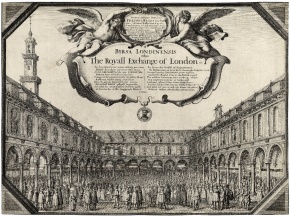
Linda Levy Peck on the Royal Exchange.
The Royal Exchange was built by Sir Thomas Gresham and opened in 1570. He built it, modeled it on the Antwerp Bourse and he needed to build it so that there would be a gathering place for international merchants in London. This was a place where international merchants could come together, could speak together, exchange news of ships that were coming in, and could buy and sell goods. They gathered together in the courtyard as you can see in Wenceslaus Hollar's print, but upstairs he also added boutiques. Now this was new. There had of course been shops before, but those shops were shops that were in the front of workshops. What was new in the Royal Exchange were that these were retail shops. One of the first shoppers was Queen Elizabeth herself, who opened the Royal Exchange. At the time, there weren't enough shops that were ready to go—and so Sir Thomas Gresham had to keep moving the goods in the Royal Exchange around to make it appear that there were sufficient shops because there just weren't enough shops fully prepared for the Queen to see. But that did not matter. The Queen was so pleased with the new set of boutiques that she allowed Sir Thomas to name the new space the Royal Exchange.
Hear about the Royal Exchange.
For more on the Royal Exchange and the rise of commerce, visit the exhibition page on Consuming Splendor: Luxury Goods in England, 1580–1680.
Linda Levy Peck has published extensively on politics, society, and culture in seventeenth-century England. She is the author of Consuming splendor: society and culture in seventeenth-century England (2005), Court Patronage and Corruption in Early Stuart England (1990), and the editor of The Mental World of the Jacobean Court (1991).
Hollar’s Long View (southwest corner)
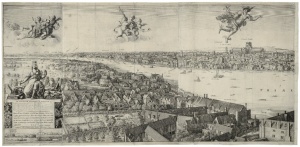
Kathleen Lynch on a Hollar's panorama.
If you stand right in the middle of this six-sheet engraving, you can take in the whole of London from almost the same observation point that Wenceslaus Hollar used for his preliminary sketches. That’s the tower of St. Mary Overy on the south bank of the Thames. Hollar’s eye takes in everything – from the countryside west of Parliament to the tidal waters east of the city. His panoramic view is remarkably accurate. Not only are individual buildings portrayed from life, but the picture rewards close study of such details as the ships, the gardens, and the courtyards. Theater historians have always been interested in this view for its prominent depiction of the Bankside playhouses. Unfortunately, the theaters are misidentified and the building labeled “Beere bayting” is in fact the Globe Theater. And the building closer to the river labeled “The Globe” is the Hope Theater, which was also known as the Bear Garden. The rhetoric of presentation is curious in a different way. The sky is emblazoned with classical cherubs, mythological figures, and contemporary exotica – a parrot, a Peruvian Indian, an ostrich feather. A monumental Nympha Britannorum guards the left flank of the picture with examples of the land’s bounty and she is matched on the right by a river god with fish and water pouring from his vessel. This view is deeply unsettled by an uncertain national fate, however. The map is dedicated to Princess Mary, Charles I’s eldest daughter. She was married to William, Prince of Orange. But in 1647, England was embroiled in a civil war, King Charles was being held prisoner, and London was almost a Parliamentary garrison. Hollar may have been prescient—Mary did play an important role in unifying the country when her son—also a William—married his cousin—another Mary—and the two brought in the glorious revolution of 1688.
Hear Lynch share insights on this etching of London.
Pericles and the Globe (case 8)
Betsy Walsh one of the Globe's first plays.
Pericles, Prince of Tyre enjoyed great popular success to the point that it stirred the envy of Ben Jonson, who dismissed it as a moldy tale. Indeed, the episodic plot is a series of highly improbable twists and turns that has a prince engaged in adventures all around the Eastern Mediterranean and ends with his reunion with Thaisa, the wife he believed had died in a shipwreck more than a decade earlier, and Marina, the daughter he had abandoned. It is the stuff of fable and a storyline that can be traced back at least to the fifth-century A.D. Pericles first appeared in print in this 1609 quarto which, as you can see, notes on the title page that it has “diverse and sundry times, been acted by the King's Men at the Globe on the Bankside.” With its many shifts in locale, Pericles was brilliantly suited to performance at the Globe Theater. Despite only minimal scenery and props, Shakespeare excelled in taking his audiences around the world and through time using his own scene-setting words to set the stage. Most scholars now agree that Pericles, like many other dramatic works of the period, was a collaborative effort between William Shakespeare and others and, perhaps for that reason, it was not included in the first folio in 1623.
Listen to Walsh discuss Shakespeare's Pericles.
Bartholomew Fair (case 9)
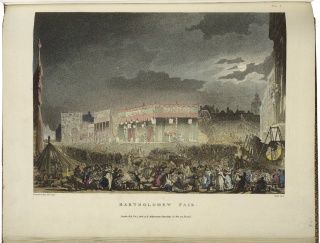
Kathleen Lynch on a summer fair.
Bartholomew Fair was London's annual cloth fair, held around the feast of St. Bartholomew, on August 25th. It was such an important event for the cloth trade that John Stow noted that the clothiers of all England joined the drapers of London to rent booths for the event. The fair's origins reach back to the twelfth century when King Henry II granted the organizing rights to the priory of St. Bartholomew and it continued into well into the nineteenth century when it included rides and stages for entertainment, as depicted in this hand-colored illustration from the beginning of that century. For seven hundred years then, Bartholomew Fair played a central role in the festive lives of Londoners for it was a festive event as well as a trade show. Early on, such activities as puppet shows, bull and bear baiting, and wrestling matches provided entertainment. Such a gathering also required the presence of an itinerant court—a dedicated Court of the Piepowders, which is a corrupted English translation of pieds poutrés, or “dusty feet,” who ruled over any disputes concerning contracts as well as disorderly conduct. No one captured the quality of that festivity better than Ben Jonson in his play, Bartholomew Fair. With over thirty named characters, Jonson filled the stage of the Hope Theater with as great a spread of humanity as he could muster. To punctuate the similarities between play-going and fair-going, Jonson also fished for laughs out of the fact that the bear-baiting that also took place at the Hope left the theater “as dirty and stinking every whit as Smithfield”—that was London’s largest open market, the great field just outside the gates of St. Bartholomew's priory, into which the fair spilled.
Hear Lynch discuss a centuries old fair.
Cockpit Theatre (case 10)
Richard Schoch on the rebirth of theaters.
With the restoration of the monarchy under Charles II in 1660, theater, although it had been heavily suppressed but not destroyed during the interregnum, became once again an important part of the city's cultural life. The king quickly issued patents for two new theatre companies—the Duke's Company, led by Sir William D’Avenant, and the King's Company, led by Thomas Killigrew. D’Avenant and Killigrew were effectively starting from scratch and this actually was a great opportunity and they made two important decisions that still today define the shape of London theater. First, they changed the location in London where theaters were built. Because the theater was identified with the Crown and with an elite audience, theaters were built in Westminster—the new, fashionable heart of London. Second, they changed the shape of theater buildings. Because a small elite audience was attracted, theater buildings were kept small and intimate, seating between 500 and 800 people. Shakespeare's Globe, by contrast, could have accommodated several thousand people. It took time to build new theaters, but the companies were under pressure to start performing quickly. D’Avenant’s company decided to perform at the Cockpit Theater, also known as the Phoenix because it had been rebuilt after a fire.
Hear Schoch discuss theater during the restoration.
Richard Schoch, is the author of Shakespeare’s Victorian Stage (1998) and Not Shakespeare (2002) and the editor of Great Shakespeareans: Macready, Booth, Terry, Irving (2011) and Victorian Theatrical Burlesques (2003).
Gangraena (case 11)
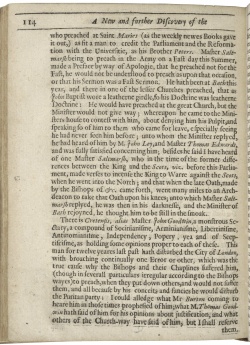
David Como on Thomas Edwards' book.
Gangraena by Thomas Edwards was published in 1646 at the end of the English Civil War. That war pitted the followers of King Charles I against the supporters of Parliament. The conflict tore England into pieces, not least by fomenting religious divisions—divisions that were occasioned by the rise of new religious ideas and novel religious sectarian groupings that rose up in the wake of the chaos of the civil wars. Nowhere were those divisions more pronounced than in the city of London, the epicenter of English religious, political, and cultural life. Now it was to try to contain those religious divisions that Thomas Edwards, a London minister, took up his pen to write Gangraena. Gangraena was an impassioned attack on these religious sects and these novel religious opinions, which Edwards saw as being a kind of cancer or a gangrene, spreading through the body politic. This page shows Edwards attacking a fellow London minister, a prominent clergyman named John Goodwin. Now although Edwards earned enormous notoriety through his attack on the sects and his book Gangraena was tremendously popular, his attempt to contain these religious divisions ultimately proved futile. Even after the reestablishment of peace in 1660 and the reestablishment of order, religious division persisted. Now this legacy of religious pluralism was one of the chief and most pronounced consequences of the English Civil War and the upheavals of the mid-seventeenth century.
Listen to Como discuss the English Civil War.
David Como is an Associate Professor of History at Stanford University.
Plague and fire (case 12)
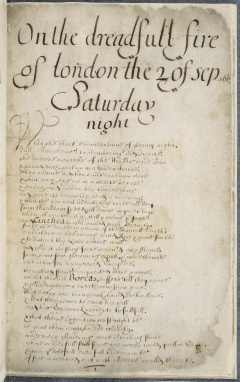
Betsy Walsh on plague and the Great Fire.
By the 1660s, London was by far the largest city in Britain. Overcrowding, unsanitary living conditions, and poorly-constructed houses, especially among the lower classes, made the people particularly vulnerable to the disastrous events that were to befall them in 1665 and 1666. In February of 1665, plague broke out on the outskirts of the city. By July, it had entered the city proper, causing King Charles II, his court, and most wealthy Londoners to flee in search of a healthier environment. In September, the death toll from the plague peaked at about 7,000 per week. Each week, London parishes recorded the number and causes of death within the parish. These statistics were printed up in lists called mortality bills. You can see by the end of December 1665, more than 68,000 in London had succumbed to the plague, although there were undoubtedly many more whose deaths were never recorded. It is estimated that as much as one-fifth of London's population was lost during this outbreak. By February 1666, the danger had subsided enough that the king and his court returned to the city and life slowly began to return to normal or, at least that is, until the evening of September 2nd, when the Great Fire of London began in a bakery on Pudding Lane. Over the next three days, it consumed a major portion of the medieval city. Details of the fire's progress and devastation were recorded not only by notables, such as Samuel Pepys and Wenceslaus Hollar, but also by ordinary citizens, such as young Samuel Wiseman, who wrote a poem about the fire. The Great Fire is often credited with ending the threat of plague in London because it did encourage the city to be rebuilt in stone. With more generous open spaces and less overcrowding, it might be said to have had a positive effect on London's future development.
Listen to Walsh discuss disastrous events that hit London in the 1600's.
Locke on toleration
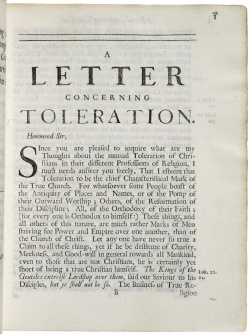
Kathleen Lynch on John Locke's principles.
“The only business of the church is salvation of souls and it is of no concern to the commonwealth or any member in it whether this ceremony or that is part of that celebration.” These are strong words from John Locke's Letter concerning toleration. The letter was written in 1685, when Locke was in exile. The exclusion crisis is the immediate context for Locke's Letter concerning toleration, but we get a better understanding of this work when we think about the 150 year history of religious persecution and retribution and in-fighting that is one of the motifs that this exhibition has documented. Locke had come to the conclusion that persecution and punishment would never secure consent to the state religion and so it was in the best interest of the state to let people worship as they pleased. Now, Locke was very much a person of his own time—by that I mean he was not willing to extend these privileges to Catholics or to atheists or to certain other religious groups. We also have to understand that while Locke was composing his observations from abroad, there were lots and lots of religious non-conformists on the streets, especially the streets of London. So you really have to put together Locke's observations in a kind of philosophical mode with the activity on the street to get a sense of what movements were forcing open the question of religious toleration.
Hear to Lynch discuss John Locke.
For more on religious tolerance, visit the exhibition page Voices for Tolerance in an Age of Persecution.
London ca. 1700
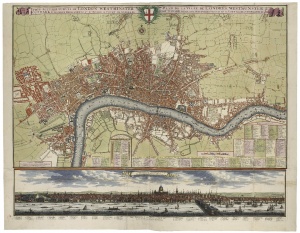
Kathleen Lynch on London's new skyline.
After the Great Fire, there were calls for a new, more orderly, more impressive street plan for London. Sir Christopher Wren produced one that was a marvel of broad boulevards radiating out from central hubs—but there were too many complications, too many individual property owners, too few records, and too great a need to get going. For the most part, the footprint of London's streets remained the same, though it was at this time that a new skyline emerged, dominated by Wren's dome of St. Paul's and the spires of the rebuilt and newly-built churches. When a call for subscriptions to a new addition of John Stow's Survey went out at the end of the seventeenth century, London was described as “the great mart and metropolis of the kingdom and the largest as well as noblest city of the world.” The keys to the administrative offices, public services, and prominent landmarks that range along the bottom margin of this map are making the same point—that London had reached a level of cosmopolitanism that put it in the first rank of European cities.
Listen to Lynch discuss the new London.